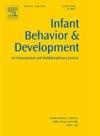婴儿操作复杂性轨迹作为2岁时语言结果的预测因子
IF 2
3区 心理学
Q3 PSYCHOLOGY, DEVELOPMENTAL
引用次数: 0
摘要
婴儿时期的运动发育为在不断变化的环境中进行社会互动提供了机会,这反过来又与语言和沟通的出现有关。利用发展级联的理论框架,我们研究了婴儿的运动轨迹,以操作复杂性(MC)来衡量,是否可以预测以后的语言技能。90名典型发育的单语英语婴儿在9至14个月大的6个月访问期间从8个物体中评估操作复杂性。MC根据以下所有可能的组合从1到8进行评分:(i)单手或双手操作;(ii)双手的同步或非同步使用;(iii)依赖或独立使用手指;(iv)手是操作一个物体还是多个物体。每个月的平均MC分数用于分析。训练有素的观察员在孩子2岁时使用第5版学前语言量表。潜类增长分析确定了两个婴儿语言能力等级:高语言能力等级和平均语言能力等级。高语料班儿童的表达性和接受性语言得分高于普通语料班儿童。研究结果揭示了运动-语言级联的潜在机制。本文章由计算机程序翻译,如有差异,请以英文原文为准。
Infant manipulation complexity trajectories as predictors of language outcomes at 2 years of age
Motor development during infancy provides opportunities for social interactions in a changing environment, which in turn, has been linked to the emergence of language and communication. Using the theoretical framework of developmental cascades, we examined whether infant motor trajectories, measured as manipulation complexity (MC), could predict later language skills. Ninety typically developing monolingual English infants were assessed for manipulation complexity at six monthly visits from 9 to 14 months of age from a battery of 8 objects. MC was scaled from 1 to 8 based on all possible combination of the following actions: (i) unimanual or bimanual manipulation; (ii) synchronous or asynchronous use of the hands; (iii) dependent or independent finger use; and (iv) whether the hands manipulated one object or multiple objects. Average MC scores from each month were used in analyses. Trained observers administered the Preschool Language Scales 5th edition when children were 2 years old. Latent class growth analysis identified two infant MC classes: high MC and average MC. MC classes predicted 2-year language skills. Children in the high MC class had higher expressive and receptive language scores relative to children in the average MC class. Results have implications for unraveling the mechanisms underlying motor-language cascades.
求助全文
通过发布文献求助,成功后即可免费获取论文全文。
去求助
来源期刊

Infant Behavior & Development
PSYCHOLOGY, DEVELOPMENTAL-
CiteScore
4.10
自引率
4.80%
发文量
94
期刊介绍:
Infant Behavior & Development publishes empirical (fundamental and clinical), theoretical, methodological and review papers. Brief reports dealing with behavioral development during infancy (up to 3 years) will also be considered. Papers of an inter- and multidisciplinary nature, for example neuroscience, non-linear dynamics and modelling approaches, are particularly encouraged. Areas covered by the journal include cognitive development, emotional development, perception, perception-action coupling, motor development and socialisation.
 求助内容:
求助内容: 应助结果提醒方式:
应助结果提醒方式:


